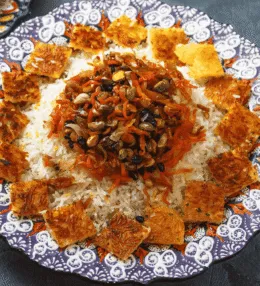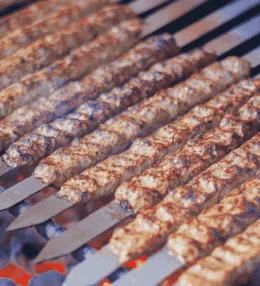
- View
Table of Contents
TogglePaella Valenciana is a dish that captures the essence of spain‘s culinary tradition, combining local ingredients with a cooking technique honed over generations.
Known for its signature golden colour and rich layers of flavour, this classic rice dish originated in Valencia, where it remains a beloved part of the local culture.
More than just a meal, Paella Valenciana is a celebration of simplicity, seasonal ingredients, and the art of cooking over an open flame, enjoyed best when shared among friends and family.
Want to dive deeper into Spanish cuisine? Don’t miss our post on 43 Traditional Spanish Foods To Try
What Is Paella Valenciana?
Paella Valenciana is the original version of paella, distinct from the seafood varieties often associated with the dish. Traditionally made with short-grain rice, rabbit, chicken, and local beans, this paella is seasoned with saffron, which gives it its distinctive golden hue.
The dish is cooked in a wide, shallow pan known as a “paellera,” which allows the rice to cook evenly and form a crispy layer at the bottom called the “socarrat.” This caramelized crust is highly prized, adding a depth of flavour and texture that makes the dish truly special.
Valencians take their paella seriously, with many believing that authentic Paella Valenciana must adhere to specific ingredients and techniques. It’s not a dish to be rushed; it’s about layering flavours, letting each ingredient shine, and achieving the perfect socarrat.
The result is a meal that’s as visually stunning as it is flavourful, evoking the rustic charm of Spanish countryside cooking.
Ingredients and Taste
The ingredients in Paella Valenciana are simple yet deeply flavourful. The rice, ideally a short grain variety like Bomba or Senia, is crucial for absorbing the broth without losing its shape.
Rabbit and chicken are traditional meats, often complemented by local varieties of beans such as “garrofó” (lima beans) and “judía verde” (green beans).
The dish is seasoned with saffron, which imparts a beautiful yellow colour and a subtle, earthy flavour that pairs perfectly with the other ingredients. Rosemary is sometimes added, lending a fragrant, herbal note that enhances the dish’s rustic quality.
As it cooks, the flavours meld together, with the rice absorbing the rich broth, a blend of stock and tomatoes simmered with the meat and vegetables.
The taste of Paella Valenciana is hearty and balanced, with each ingredient contributing to a complex but cohesive flavour. The rabbit and chicken provide tender, savoury bites, while the beans add a contrasting texture.
The socarrat, the crispy layer at the bottom, is a treat, crunchy, caramelized, and slightly smoky, adding a burst of flavour to every forkful. Each bite reveals a taste of saffron, garlic, and rosemary, giving the dish an unmistakable Mediterranean profile.
A Taste of History
Paella Valenciana’s origins lie in the fields of Valencia, where it was initially a rural dish cooked by farmers and labourers using whatever ingredients were on hand. The wide, shallow pan allowed the rice to cook evenly over an open flame, making it ideal for communal cooking in the countryside.
Originally, paella was made with ingredients that were readily available, rabbits and chickens from local farms, fresh beans, and saffron grown in the region. This modest beginning is a testament to the resourcefulness of Valencia’s people, transforming simple ingredients into a dish rich in flavour and tradition.
Over time, Paella Valenciana became a culinary icon, embodying the spirit of Valencia’s people and culture. Its recipe has remained largely unchanged, and locals still insist on using traditional methods and ingredients.
Today, paella is enjoyed worldwide, but in Valencia, it’s more than just food; it’s a source of pride and a ritual of connection, with families gathering on Sundays to cook and enjoy it together.

Spanish Paella Valenciana (Valencian Rice Dish)
Ingredients
- 1/4 cup olive oil
- 200 g chicken drumsticks skin on
- 200 g rabbit cut into small pieces
- 1 medium ripe tomato grated
- 1/2 cup green beans bajoqueta, trimmed and cut into 2-inch pieces
- 1/4 cup garrofó large white beans, soaked if dried
- 1/4 cup lima beans optional, if garrofó is unavailable
- 1 tsp smoked paprika
- 1 pinch saffron threads
- 1/4 cup canned or fresh artichoke hearts optional
- 1 sprig fresh rosemary
- 1 1/2 cups short-grain rice such as Bomba or Calasparra rice
- 4 cups chicken broth or water
- Salt to taste
Instructions
- To begin, heat a wide, shallow paella pan over medium heat, and add 1/4 cup olive oil. Once the oil is hot, add the chicken and rabbit pieces, browning them for 5-6 minutes on each side until golden. This step infuses the oil with rich flavours and builds a flavourful base.
- Add the green beans, garrofó, and lima beans (if using). Sauté the beans with the meats for 3-4 minutes until they begin to soften. Stir occasionally to avoid burning and allow all ingredients to cook evenly.
- Add the grated tomato to the pan, stirring well to coat all the ingredients. Allow the tomato to cook down for 2-3 minutes until it releases its juices and forms a thick paste. This forms the sofrito, a traditional flavour base for paella.
- Sprinkle in 1 tsp of smoked paprika, stirring quickly to prevent it from burning. Then, add the saffron threads by lightly crumbling them between your fingers, allowing their flavour to infuse into the dish. This provides the dish’s iconic colour and aroma.
- Pour in 4 cups of chicken broth, stirring to combine. Add salt to taste and the sprig of rosemary, which imparts a subtle earthy flavour. Bring the liquid to a boil, then lower the heat and simmer for 10 minutes, allowing the ingredients to meld.
- Evenly distribute the 1 1/2 cups of short-grain rice in the pan, ensuring it’s spread evenly across the surface. Do not stir the rice once added, as this helps form the crispy base layer known as socarrat, an essential part of authentic paella.
- Arrange the artichoke hearts (if using) on top of the rice, lightly pressing them in. Let the paella cook over medium heat, uncovered, for 18-20 minutes. As the liquid reduces, the rice should absorb the flavours of the stock and saffron.
- Once the liquid is absorbed and the rice is tender, remove the rosemary sprig and check for the socarrat at the bottom by gently scraping. Serve the paella directly from the pan for an authentic touch. Garnish with fresh rosemary if desired, and enjoy with lemon wedges for a refreshing citrus accent.
Nutrition
You May Also Like






